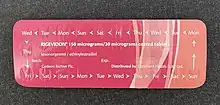Ethinylestradiol/levonorgestrel
Ethinylestradiol/levonorgestrel (EE/LNG) is a combined birth control pill made up of ethinylestradiol, an estrogen and levonorgestrel a progestin.[2] It is used for birth control, symptoms of menstruation, endometriosis, and as emergency contraception.[1][2] It is taken by mouth.[1] Some preparations of EE/LNG additionally contain an iron supplement in the form of ferrous bisglycinate or ferrous fumarate.[3]
| Combination of | |
|---|---|
| Ethinylestradiol | Estrogen |
| Levonorgestrel | Progestogen |
| Clinical data | |
| Trade names | Altavera, Alysena, Amethyst, others[1] |
| Other names | EE/LNG |
| AHFS/Drugs.com | Monograph |
| MedlinePlus | a601050 |
| Routes of administration | By mouth |
| ATC code | |
| Legal status | |
| Legal status |
|
| Identifiers | |
| CAS Number | |
| KEGG | |

Side effects can include nausea, headache, blood clots, breast pain, depression, and liver problems.[2] Use is not recommended during pregnancy, the initial three weeks after childbirth, and in those at high risk of blood clots.[2] However, it may be started immediately after a miscarriage or abortion.[4] Smoking while using combined birth control pills is not recommended.[1] It works by stopping ovulation, making the mucus at the opening to the cervix thick, and making the uterus not suitable for implantation.[1]
Ethinylestradiol/levonorgestrel has been approved for medical use in the United States at least since 1982.[1] It is on the World Health Organization's List of Essential Medicines.[5] It is available as a generic medication.[6] It is marketed under a large number of brand names.[1] In 2019, it was the 124th most commonly prescribed medication in the United States, with more than 5 million prescriptions.[7][8]
References
- "Ethinyl estradiol and levonorgestrel medical facts from Drugs.com". www.drugs.com. Archived from the original on 1 January 2017. Retrieved 1 January 2017.
- World Health Organization (2009). Stuart MC, Kouimtzi M, Hill SR (eds.). WHO Model Formulary 2008. World Health Organization. pp. 363–5. hdl:10665/44053. ISBN 9789241547659.
- Editor in Chief, Richard J. Hamilton MD FAAEM FACMT FACEP (30 April 2020). Tarascon Pocket Pharmacopoeia 2020 Deluxe Lab-Coat Edition. Jones & Bartlett Learning. pp. 347–. ISBN 978-1-284-40304-6.
{{cite book}}:|author=has generic name (help) - "Erlibelle 30micrograms/150micrograms film-coated tablets - Summary of Product Characteristics (SPC) - (eMC)". www.medicines.org.uk. Archived from the original on 2 January 2017. Retrieved 1 January 2017.
- World Health Organization (2019). World Health Organization model list of essential medicines: 21st list 2019. Geneva: World Health Organization. hdl:10665/325771. WHO/MVP/EMP/IAU/2019.06. License: CC BY-NC-SA 3.0 IGO.
- Hamilton, Richart (2015). Tarascon Pocket Pharmacopoeia 2015 Deluxe Lab-Coat Edition. Jones & Bartlett Learning. p. 349. ISBN 9781284057560.
- "The Top 300 of 2019". ClinCalc. Retrieved 16 October 2021.
- "Ethinyl Estradiol; Levonorgestrel - Drug Usage Statistics". ClinCalc. Retrieved 16 October 2021.